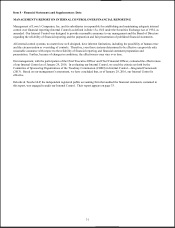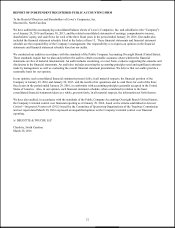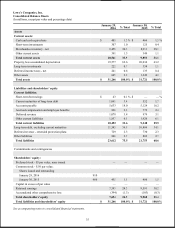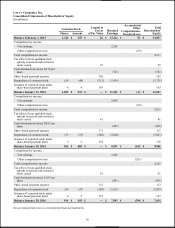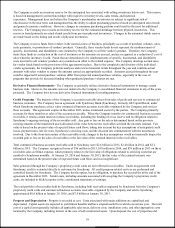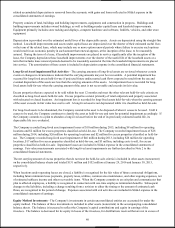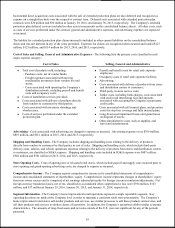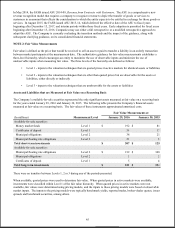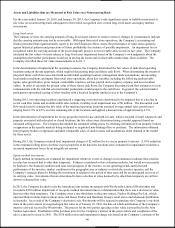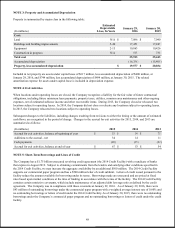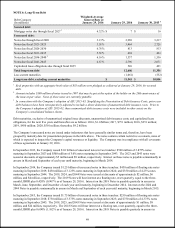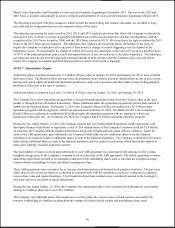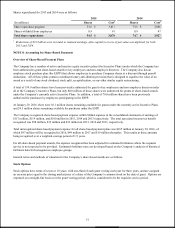Lowe's 2015 Annual Report Download - page 50
Download and view the complete annual report
Please find page 50 of the 2015 Lowe's annual report below. You can navigate through the pages in the report by either clicking on the pages listed below, or by using the keyword search tool below to find specific information within the annual report.
41
the carrying amount of the investments, and for any other than temporary impairment losses recognized. The Company’s
equity in earnings and losses of the investees and other than temporary impairment losses are included in SG&A expense.
Equity method investments are evaluated for impairment whenever events or changes in circumstances indicate that a decline
in value has occurred that is other than temporary. Evidence considered in this evaluation includes, but would not necessarily
be limited to, the financial condition and near-term prospects of the investee, recent operating trends and forecasted
performance of the investee, market conditions in the geographic area or industry in which the investee operates and the
Company’s strategic plans for holding the investment in relation to the period of time expected for an anticipated recovery of
its carrying value. Investments that are determined to have a decline in value deemed to be other than temporary are written
down to estimated fair value.
In 2015, the Company decided to exit the Australian joint venture investment with Woolworths Limited (Woolworths) and
recorded a $530 million impairment of its equity method investment due to a determination that there was a decrease in value
that was other than temporary (see Note 2 to the consolidated financial statements for further discussion). Exclusive of this
impairment charge recognized in the current year, losses on equity method investments have been immaterial.
Leases - For lease agreements that provide for escalating rent payments or free-rent occupancy periods, the Company
recognizes rent expense on a straight-line basis over the non-cancellable lease term and option renewal periods where failure to
exercise such options would result in an economic penalty in such amount that renewal appears, at the inception of the lease, to
be reasonably assured. The lease term commences on the date that the Company takes possession of or controls the physical
use of the property. Deferred rent is included in other liabilities (noncurrent) on the consolidated balance sheets.
When the Company renegotiates and amends a lease to extend the non-cancellable lease term prior to the date at which it would
have been required to exercise or decline a term extension option, the amendment is treated as a new lease. The new lease
begins on the date the lease amendment is entered into and ends on the last date of the non-cancellable lease term, as adjusted
to include any option renewal periods where failure to exercise such options would result in an economic penalty in such
amount that renewal appears, at the inception of the lease amendment, to be reasonably assured. The new lease is classified as
operating or capital under the authoritative guidance through use of assumptions regarding residual value, economic life,
incremental borrowing rate, and fair value of the leased asset(s) as of the date of the amendment.
Accounts Payable - The Company has an agreement with a third party to provide an accounts payable tracking system which
facilitates participating suppliers’ ability to finance payment obligations from the Company with designated third-party
financial institutions. Participating suppliers may, at their sole discretion, make offers to finance one or more payment
obligations of the Company prior to their scheduled due dates at a discounted price to participating financial institutions. The
Company’s goal in entering into this arrangement is to capture overall supply chain savings, in the form of pricing, payment
terms, or vendor funding, created by facilitating suppliers’ ability to finance payment obligations at more favorable discount
rates, while providing them with greater working capital flexibility.
The Company’s obligations to its suppliers, including amounts due and scheduled payment dates, are not impacted by
suppliers’ decisions to finance amounts under this arrangement. However, the Company’s right to offset balances due from
suppliers against payment obligations is restricted by this arrangement for those payment obligations that have been financed
by suppliers. As of January 29, 2016 and January 30, 2015, $1.3 billion and $1.0 billion, respectively, of the Company’s
outstanding payment obligations had been placed on the accounts payable tracking system, and participating suppliers had
financed $921 million and $724 million, respectively, of those payment obligations to participating financial institutions.
Other Current Liabilities - Other current liabilities on the consolidated balance sheets consist of:
(In millions)
January 29, 2016
January 30, 2015
Self-insurance liabilities
$
343
$
346
Accrued dividends
255
222
Accrued interest
179
165
Sales tax liabilities
140
131
Accrued property taxes
111
124
Other
829
932
Tota l
$
1,857
$
1,920


